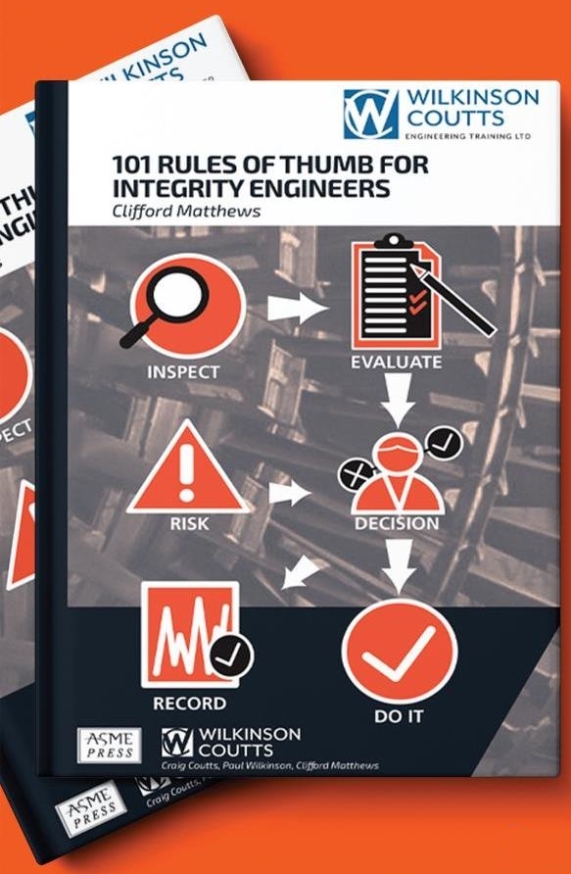101 Rules of Thumb for Integrity Engineers
Writing a book about integrity engineering infers you can learn it from books. It’s sort of true, but there are plenty of books. And codes, recommended practices technical papers and all those other sources, thousands of them, you don’t have time to read.
Can we shrink them down to the most important ones? Pick out those with superlative general application, squeeze each page or two and then call them something snappy like … Rules of Thumb? It’s a massive call.
WE’VE HAD A TRY: HERE THEY ARE
Rule Subject
0 Rules of thumb
1 Integrity assessment: What is it?
2 Money matters (indeed it does)
3 Hate surprises, ——————- UUGH…NO-ONE LIKES THESE
4 Easy or difficult?
5 It’s not only about codes
6 Ask your grandfather
7 Audit your skills (no-one like that)
8 Equipment items are different
9 Don’t confuse DMs and FMs
10 Look for the dominant DM-FM combination
11 Multiple contributory causes ————-HUNT THEM DOWN…THEY’RE THERE
12 Offer multiple solution avenues
13 Recognise ‘Imminent Danger’
14 Learning from near-misses
15 True IOWs are elusive
16 Improve weak WSEs —————- PLENTY OF THESE ABOUT
17 Beware DEAD data
18 Don’t confuse MDMT and MAT
19 Living with weld defects
20 How relevant is piping tmin?
21 Simple pressure vessel tmin
22 Corroded heads: Which formula?
23 Deciding allowable stress (S)
24 Danger: Rogue materials —————– WE KNOW WHERE THEY COME FROM
25 Hardness measurement
26 Hardness readings for SSC resistance
27 What metallurgical tests can’t tell you
28 Brittle fracture worries
29 Weld susceptibility to fatigue
30 Improving weld fatigue resistance
31 Don’t squander time
32 Think about damage (in) tolerance
33 Low-risk vessels
34 High-risk vessels
35 Piping systems
36 Storage tanks
37 Pipeline dents, distortions and defects
38 Why package boilers fail
39 Package boiler peaking
40 Horizons
41 NDE can’t tell you everything
42 How effective is NDE? —————— PERHAPS LESS THAN YOU THINK
43 Detection is different to sizing
44 The problem with benchmark corrosion rates
45 Defect acceptance criteria?
46 Point-to-point or circuit analysis?
47 Unknown corrosion rates ——————— NOW WHAT DO YOU DO?
48 BAD CMLs give BAD data
49 Beware of statistical mania
50 Process towers have multiple corrosion rates
51 CUI means unpopular inspections
52 Adding tank bottom corrosion rates
53 Know your averaging length
54 Averaging length examples
55 Wall thinning? Think COV
56 Using NII
57 Cheap NII? ——————- POSSIBLY?…MAYBE?…..MAYBE NOT
58 Always NII?
59 NII for inspection deferrals
60 Inspection effectiveness? Be realistic
61 Integrity assessments: Past and future
62 API RP 579 FFS level?
63 Consider the unexpected
64 Don’t use L1/L2 FFS for invalid components
65 Eyes open for complicating conditions
66 Tricky discontinuity stress
67 Structural discontinuity problems
68 Advice about crack assessments ———————WHY TO BE WARY OF THEM
69 Fatigue assessment: The problem is data
70 How to assess pitting
71 Planning RBI? Check your capability
72 Hazard levels: Consequences are the easiest to predict
73 Generic failure frequencies GFFs…——————FACT OR FANTASY?
74 Link API RP 571 and 581 for better RBI
75 The 90/95 POD rule
76 Location governs risk
77 Fatigue resistance factors
78 Damage factors Df for wall thinning inspection = —————— CONFIDENCE
79 Linings: Application breakdown
80 Temporary repairs risks
81 Repair action windows: How long? —————— IF IN DOUBT…..PROCRASTINATE?
82 Specifying weld repairs
83 Big bad lap patches?
84 Vessel repair tolerances
85 Are leak-box repairs code-compliant?
86 Good CDW repairs
87 When not to use composite wraps
88 Need a pressure test?
89 Rerating can be controversial
90 Re-rating ‘plus’: Recertifying unknown vessels
91 Tank bottoms are special ——————-WHY?
92 Flange face defects
93 Watch for threaded connector problems
94 Safety valves: Strip down or not?
95 Safety valves: Set point and tolerances
96 Thinning of shop-fabricated tanks
97 What type of failure?
98 Think about foreseeability ————–FORESEEABILITY —…..FRIEND OR FOE?
99 Benchmarks act against you
100 Who learns from failures?
101 After all this: Whose fault was it?
Wow! That was a battle, not a holiday. Please try some of the 101 rules.
They all work.
















UK customers: purchase online for tracked courier despatch free to UK destinations.
For overseas customers, please contact us first on matthewsnotes@aol.com for shipping costs and payment. We can accept payment via PayPal.
Call us on +44 7746 771592 for order queries.


Publisher: Matthews Engineering Training Ltd/Wilkinson Coutts Ltd
ISBN: 978-1-7398630-1-2. 310 pages hardback. Wt 700g: 249 x 152 30mm
